Biophysical and Psychosocial Processes in Dementia Patients
VerifiedAdded on 2023/06/03
|7
|2712
|191
AI Summary
This article discusses three case studies on dementia patients, their biophysical and psychosocial processes, appropriate assessment tools, and prioritized care areas. It also highlights equity, rights, and access issues relevant to the case.
Contribute Materials
Your contribution can guide someone’s learning journey. Share your
documents today.

UNIT:
NAME:
DATE:
NAME:
DATE:
Secure Best Marks with AI Grader
Need help grading? Try our AI Grader for instant feedback on your assignments.
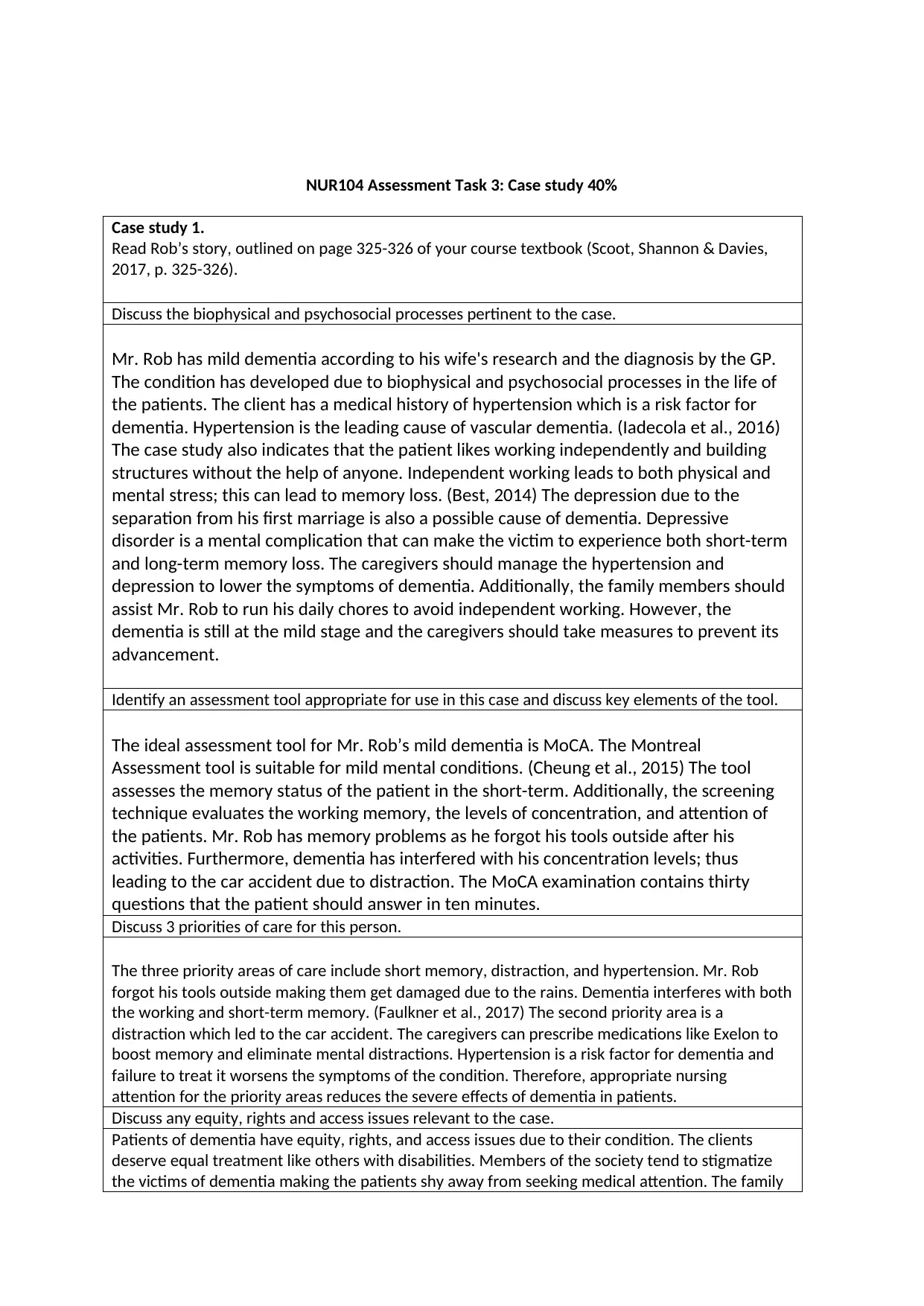
NUR104 Assessment Task 3: Case study 40%
Case study 1.
Read Rob’s story, outlined on page 325-326 of your course textbook (Scoot, Shannon & Davies,
2017, p. 325-326).
Discuss the biophysical and psychosocial processes pertinent to the case.
Mr. Rob has mild dementia according to his wife's research and the diagnosis by the GP.
The condition has developed due to biophysical and psychosocial processes in the life of
the patients. The client has a medical history of hypertension which is a risk factor for
dementia. Hypertension is the leading cause of vascular dementia. (Iadecola et al., 2016)
The case study also indicates that the patient likes working independently and building
structures without the help of anyone. Independent working leads to both physical and
mental stress; this can lead to memory loss. (Best, 2014) The depression due to the
separation from his first marriage is also a possible cause of dementia. Depressive
disorder is a mental complication that can make the victim to experience both short-term
and long-term memory loss. The caregivers should manage the hypertension and
depression to lower the symptoms of dementia. Additionally, the family members should
assist Mr. Rob to run his daily chores to avoid independent working. However, the
dementia is still at the mild stage and the caregivers should take measures to prevent its
advancement.
Identify an assessment tool appropriate for use in this case and discuss key elements of the tool.
The ideal assessment tool for Mr. Rob’s mild dementia is MoCA. The Montreal
Assessment tool is suitable for mild mental conditions. (Cheung et al., 2015) The tool
assesses the memory status of the patient in the short-term. Additionally, the screening
technique evaluates the working memory, the levels of concentration, and attention of
the patients. Mr. Rob has memory problems as he forgot his tools outside after his
activities. Furthermore, dementia has interfered with his concentration levels; thus
leading to the car accident due to distraction. The MoCA examination contains thirty
questions that the patient should answer in ten minutes.
Discuss 3 priorities of care for this person.
The three priority areas of care include short memory, distraction, and hypertension. Mr. Rob
forgot his tools outside making them get damaged due to the rains. Dementia interferes with both
the working and short-term memory. (Faulkner et al., 2017) The second priority area is a
distraction which led to the car accident. The caregivers can prescribe medications like Exelon to
boost memory and eliminate mental distractions. Hypertension is a risk factor for dementia and
failure to treat it worsens the symptoms of the condition. Therefore, appropriate nursing
attention for the priority areas reduces the severe effects of dementia in patients.
Discuss any equity, rights and access issues relevant to the case.
Patients of dementia have equity, rights, and access issues due to their condition. The clients
deserve equal treatment like others with disabilities. Members of the society tend to stigmatize
the victims of dementia making the patients shy away from seeking medical attention. The family
Case study 1.
Read Rob’s story, outlined on page 325-326 of your course textbook (Scoot, Shannon & Davies,
2017, p. 325-326).
Discuss the biophysical and psychosocial processes pertinent to the case.
Mr. Rob has mild dementia according to his wife's research and the diagnosis by the GP.
The condition has developed due to biophysical and psychosocial processes in the life of
the patients. The client has a medical history of hypertension which is a risk factor for
dementia. Hypertension is the leading cause of vascular dementia. (Iadecola et al., 2016)
The case study also indicates that the patient likes working independently and building
structures without the help of anyone. Independent working leads to both physical and
mental stress; this can lead to memory loss. (Best, 2014) The depression due to the
separation from his first marriage is also a possible cause of dementia. Depressive
disorder is a mental complication that can make the victim to experience both short-term
and long-term memory loss. The caregivers should manage the hypertension and
depression to lower the symptoms of dementia. Additionally, the family members should
assist Mr. Rob to run his daily chores to avoid independent working. However, the
dementia is still at the mild stage and the caregivers should take measures to prevent its
advancement.
Identify an assessment tool appropriate for use in this case and discuss key elements of the tool.
The ideal assessment tool for Mr. Rob’s mild dementia is MoCA. The Montreal
Assessment tool is suitable for mild mental conditions. (Cheung et al., 2015) The tool
assesses the memory status of the patient in the short-term. Additionally, the screening
technique evaluates the working memory, the levels of concentration, and attention of
the patients. Mr. Rob has memory problems as he forgot his tools outside after his
activities. Furthermore, dementia has interfered with his concentration levels; thus
leading to the car accident due to distraction. The MoCA examination contains thirty
questions that the patient should answer in ten minutes.
Discuss 3 priorities of care for this person.
The three priority areas of care include short memory, distraction, and hypertension. Mr. Rob
forgot his tools outside making them get damaged due to the rains. Dementia interferes with both
the working and short-term memory. (Faulkner et al., 2017) The second priority area is a
distraction which led to the car accident. The caregivers can prescribe medications like Exelon to
boost memory and eliminate mental distractions. Hypertension is a risk factor for dementia and
failure to treat it worsens the symptoms of the condition. Therefore, appropriate nursing
attention for the priority areas reduces the severe effects of dementia in patients.
Discuss any equity, rights and access issues relevant to the case.
Patients of dementia have equity, rights, and access issues due to their condition. The clients
deserve equal treatment like others with disabilities. Members of the society tend to stigmatize
the victims of dementia making the patients shy away from seeking medical attention. The family
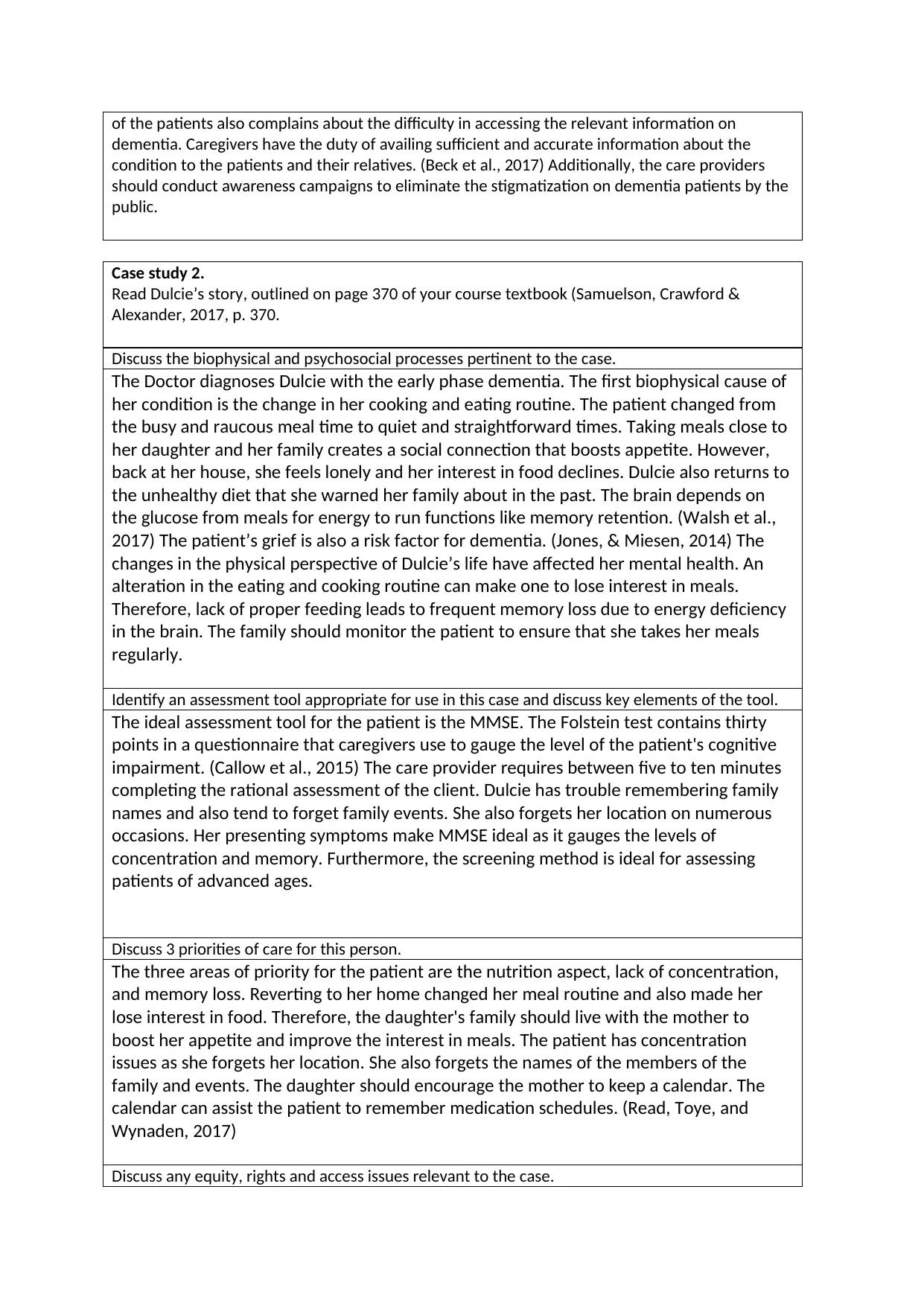
of the patients also complains about the difficulty in accessing the relevant information on
dementia. Caregivers have the duty of availing sufficient and accurate information about the
condition to the patients and their relatives. (Beck et al., 2017) Additionally, the care providers
should conduct awareness campaigns to eliminate the stigmatization on dementia patients by the
public.
Case study 2.
Read Dulcie’s story, outlined on page 370 of your course textbook (Samuelson, Crawford &
Alexander, 2017, p. 370.
Discuss the biophysical and psychosocial processes pertinent to the case.
The Doctor diagnoses Dulcie with the early phase dementia. The first biophysical cause of
her condition is the change in her cooking and eating routine. The patient changed from
the busy and raucous meal time to quiet and straightforward times. Taking meals close to
her daughter and her family creates a social connection that boosts appetite. However,
back at her house, she feels lonely and her interest in food declines. Dulcie also returns to
the unhealthy diet that she warned her family about in the past. The brain depends on
the glucose from meals for energy to run functions like memory retention. (Walsh et al.,
2017) The patient’s grief is also a risk factor for dementia. (Jones, & Miesen, 2014) The
changes in the physical perspective of Dulcie’s life have affected her mental health. An
alteration in the eating and cooking routine can make one to lose interest in meals.
Therefore, lack of proper feeding leads to frequent memory loss due to energy deficiency
in the brain. The family should monitor the patient to ensure that she takes her meals
regularly.
Identify an assessment tool appropriate for use in this case and discuss key elements of the tool.
The ideal assessment tool for the patient is the MMSE. The Folstein test contains thirty
points in a questionnaire that caregivers use to gauge the level of the patient's cognitive
impairment. (Callow et al., 2015) The care provider requires between five to ten minutes
completing the rational assessment of the client. Dulcie has trouble remembering family
names and also tend to forget family events. She also forgets her location on numerous
occasions. Her presenting symptoms make MMSE ideal as it gauges the levels of
concentration and memory. Furthermore, the screening method is ideal for assessing
patients of advanced ages.
Discuss 3 priorities of care for this person.
The three areas of priority for the patient are the nutrition aspect, lack of concentration,
and memory loss. Reverting to her home changed her meal routine and also made her
lose interest in food. Therefore, the daughter's family should live with the mother to
boost her appetite and improve the interest in meals. The patient has concentration
issues as she forgets her location. She also forgets the names of the members of the
family and events. The daughter should encourage the mother to keep a calendar. The
calendar can assist the patient to remember medication schedules. (Read, Toye, and
Wynaden, 2017)
Discuss any equity, rights and access issues relevant to the case.
dementia. Caregivers have the duty of availing sufficient and accurate information about the
condition to the patients and their relatives. (Beck et al., 2017) Additionally, the care providers
should conduct awareness campaigns to eliminate the stigmatization on dementia patients by the
public.
Case study 2.
Read Dulcie’s story, outlined on page 370 of your course textbook (Samuelson, Crawford &
Alexander, 2017, p. 370.
Discuss the biophysical and psychosocial processes pertinent to the case.
The Doctor diagnoses Dulcie with the early phase dementia. The first biophysical cause of
her condition is the change in her cooking and eating routine. The patient changed from
the busy and raucous meal time to quiet and straightforward times. Taking meals close to
her daughter and her family creates a social connection that boosts appetite. However,
back at her house, she feels lonely and her interest in food declines. Dulcie also returns to
the unhealthy diet that she warned her family about in the past. The brain depends on
the glucose from meals for energy to run functions like memory retention. (Walsh et al.,
2017) The patient’s grief is also a risk factor for dementia. (Jones, & Miesen, 2014) The
changes in the physical perspective of Dulcie’s life have affected her mental health. An
alteration in the eating and cooking routine can make one to lose interest in meals.
Therefore, lack of proper feeding leads to frequent memory loss due to energy deficiency
in the brain. The family should monitor the patient to ensure that she takes her meals
regularly.
Identify an assessment tool appropriate for use in this case and discuss key elements of the tool.
The ideal assessment tool for the patient is the MMSE. The Folstein test contains thirty
points in a questionnaire that caregivers use to gauge the level of the patient's cognitive
impairment. (Callow et al., 2015) The care provider requires between five to ten minutes
completing the rational assessment of the client. Dulcie has trouble remembering family
names and also tend to forget family events. She also forgets her location on numerous
occasions. Her presenting symptoms make MMSE ideal as it gauges the levels of
concentration and memory. Furthermore, the screening method is ideal for assessing
patients of advanced ages.
Discuss 3 priorities of care for this person.
The three areas of priority for the patient are the nutrition aspect, lack of concentration,
and memory loss. Reverting to her home changed her meal routine and also made her
lose interest in food. Therefore, the daughter's family should live with the mother to
boost her appetite and improve the interest in meals. The patient has concentration
issues as she forgets her location. She also forgets the names of the members of the
family and events. The daughter should encourage the mother to keep a calendar. The
calendar can assist the patient to remember medication schedules. (Read, Toye, and
Wynaden, 2017)
Discuss any equity, rights and access issues relevant to the case.
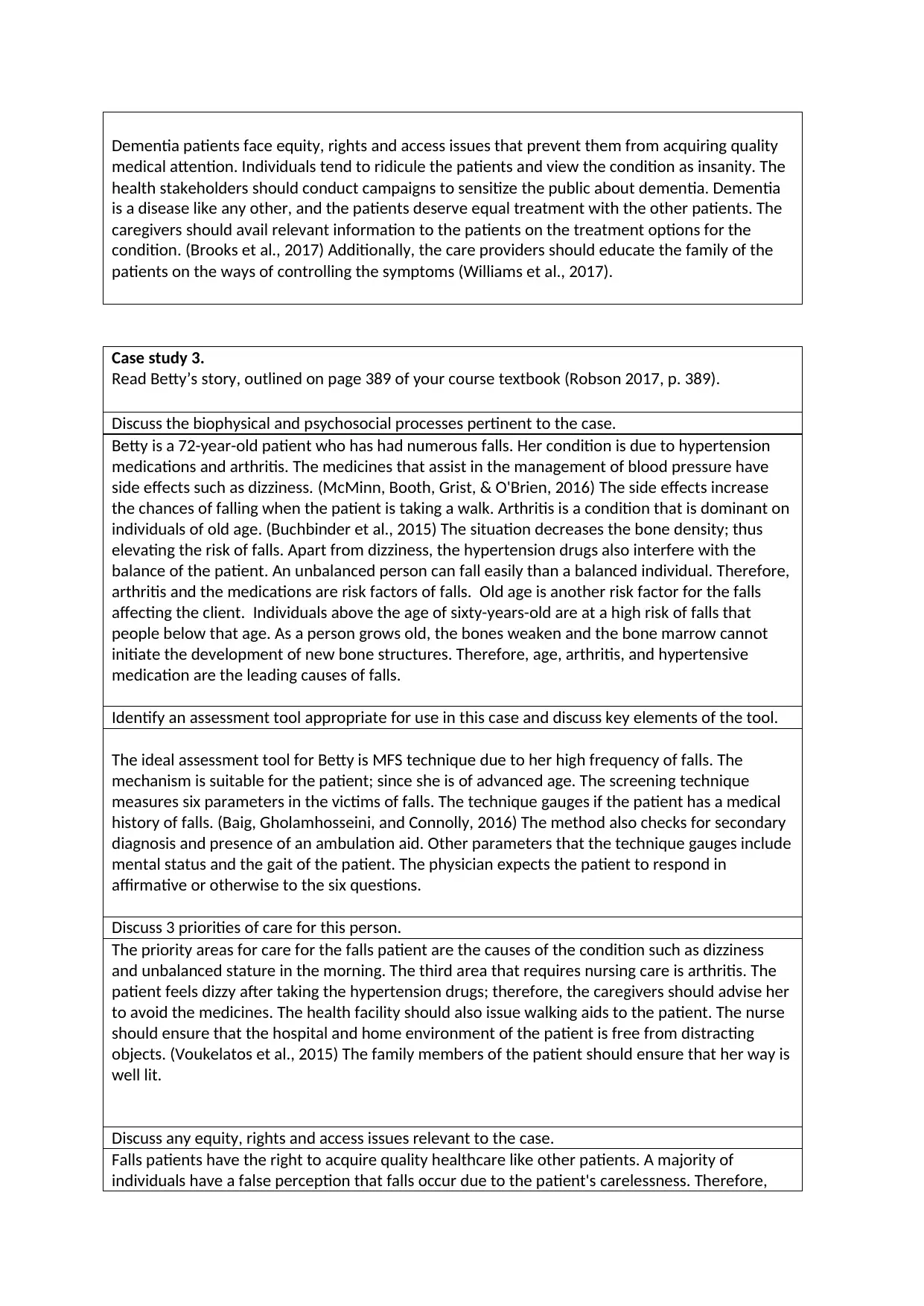
Dementia patients face equity, rights and access issues that prevent them from acquiring quality
medical attention. Individuals tend to ridicule the patients and view the condition as insanity. The
health stakeholders should conduct campaigns to sensitize the public about dementia. Dementia
is a disease like any other, and the patients deserve equal treatment with the other patients. The
caregivers should avail relevant information to the patients on the treatment options for the
condition. (Brooks et al., 2017) Additionally, the care providers should educate the family of the
patients on the ways of controlling the symptoms (Williams et al., 2017).
Case study 3.
Read Betty’s story, outlined on page 389 of your course textbook (Robson 2017, p. 389).
Discuss the biophysical and psychosocial processes pertinent to the case.
Betty is a 72-year-old patient who has had numerous falls. Her condition is due to hypertension
medications and arthritis. The medicines that assist in the management of blood pressure have
side effects such as dizziness. (McMinn, Booth, Grist, & O'Brien, 2016) The side effects increase
the chances of falling when the patient is taking a walk. Arthritis is a condition that is dominant on
individuals of old age. (Buchbinder et al., 2015) The situation decreases the bone density; thus
elevating the risk of falls. Apart from dizziness, the hypertension drugs also interfere with the
balance of the patient. An unbalanced person can fall easily than a balanced individual. Therefore,
arthritis and the medications are risk factors of falls. Old age is another risk factor for the falls
affecting the client. Individuals above the age of sixty-years-old are at a high risk of falls that
people below that age. As a person grows old, the bones weaken and the bone marrow cannot
initiate the development of new bone structures. Therefore, age, arthritis, and hypertensive
medication are the leading causes of falls.
Identify an assessment tool appropriate for use in this case and discuss key elements of the tool.
The ideal assessment tool for Betty is MFS technique due to her high frequency of falls. The
mechanism is suitable for the patient; since she is of advanced age. The screening technique
measures six parameters in the victims of falls. The technique gauges if the patient has a medical
history of falls. (Baig, Gholamhosseini, and Connolly, 2016) The method also checks for secondary
diagnosis and presence of an ambulation aid. Other parameters that the technique gauges include
mental status and the gait of the patient. The physician expects the patient to respond in
affirmative or otherwise to the six questions.
Discuss 3 priorities of care for this person.
The priority areas for care for the falls patient are the causes of the condition such as dizziness
and unbalanced stature in the morning. The third area that requires nursing care is arthritis. The
patient feels dizzy after taking the hypertension drugs; therefore, the caregivers should advise her
to avoid the medicines. The health facility should also issue walking aids to the patient. The nurse
should ensure that the hospital and home environment of the patient is free from distracting
objects. (Voukelatos et al., 2015) The family members of the patient should ensure that her way is
well lit.
Discuss any equity, rights and access issues relevant to the case.
Falls patients have the right to acquire quality healthcare like other patients. A majority of
individuals have a false perception that falls occur due to the patient's carelessness. Therefore,
medical attention. Individuals tend to ridicule the patients and view the condition as insanity. The
health stakeholders should conduct campaigns to sensitize the public about dementia. Dementia
is a disease like any other, and the patients deserve equal treatment with the other patients. The
caregivers should avail relevant information to the patients on the treatment options for the
condition. (Brooks et al., 2017) Additionally, the care providers should educate the family of the
patients on the ways of controlling the symptoms (Williams et al., 2017).
Case study 3.
Read Betty’s story, outlined on page 389 of your course textbook (Robson 2017, p. 389).
Discuss the biophysical and psychosocial processes pertinent to the case.
Betty is a 72-year-old patient who has had numerous falls. Her condition is due to hypertension
medications and arthritis. The medicines that assist in the management of blood pressure have
side effects such as dizziness. (McMinn, Booth, Grist, & O'Brien, 2016) The side effects increase
the chances of falling when the patient is taking a walk. Arthritis is a condition that is dominant on
individuals of old age. (Buchbinder et al., 2015) The situation decreases the bone density; thus
elevating the risk of falls. Apart from dizziness, the hypertension drugs also interfere with the
balance of the patient. An unbalanced person can fall easily than a balanced individual. Therefore,
arthritis and the medications are risk factors of falls. Old age is another risk factor for the falls
affecting the client. Individuals above the age of sixty-years-old are at a high risk of falls that
people below that age. As a person grows old, the bones weaken and the bone marrow cannot
initiate the development of new bone structures. Therefore, age, arthritis, and hypertensive
medication are the leading causes of falls.
Identify an assessment tool appropriate for use in this case and discuss key elements of the tool.
The ideal assessment tool for Betty is MFS technique due to her high frequency of falls. The
mechanism is suitable for the patient; since she is of advanced age. The screening technique
measures six parameters in the victims of falls. The technique gauges if the patient has a medical
history of falls. (Baig, Gholamhosseini, and Connolly, 2016) The method also checks for secondary
diagnosis and presence of an ambulation aid. Other parameters that the technique gauges include
mental status and the gait of the patient. The physician expects the patient to respond in
affirmative or otherwise to the six questions.
Discuss 3 priorities of care for this person.
The priority areas for care for the falls patient are the causes of the condition such as dizziness
and unbalanced stature in the morning. The third area that requires nursing care is arthritis. The
patient feels dizzy after taking the hypertension drugs; therefore, the caregivers should advise her
to avoid the medicines. The health facility should also issue walking aids to the patient. The nurse
should ensure that the hospital and home environment of the patient is free from distracting
objects. (Voukelatos et al., 2015) The family members of the patient should ensure that her way is
well lit.
Discuss any equity, rights and access issues relevant to the case.
Falls patients have the right to acquire quality healthcare like other patients. A majority of
individuals have a false perception that falls occur due to the patient's carelessness. Therefore,
Secure Best Marks with AI Grader
Need help grading? Try our AI Grader for instant feedback on your assignments.
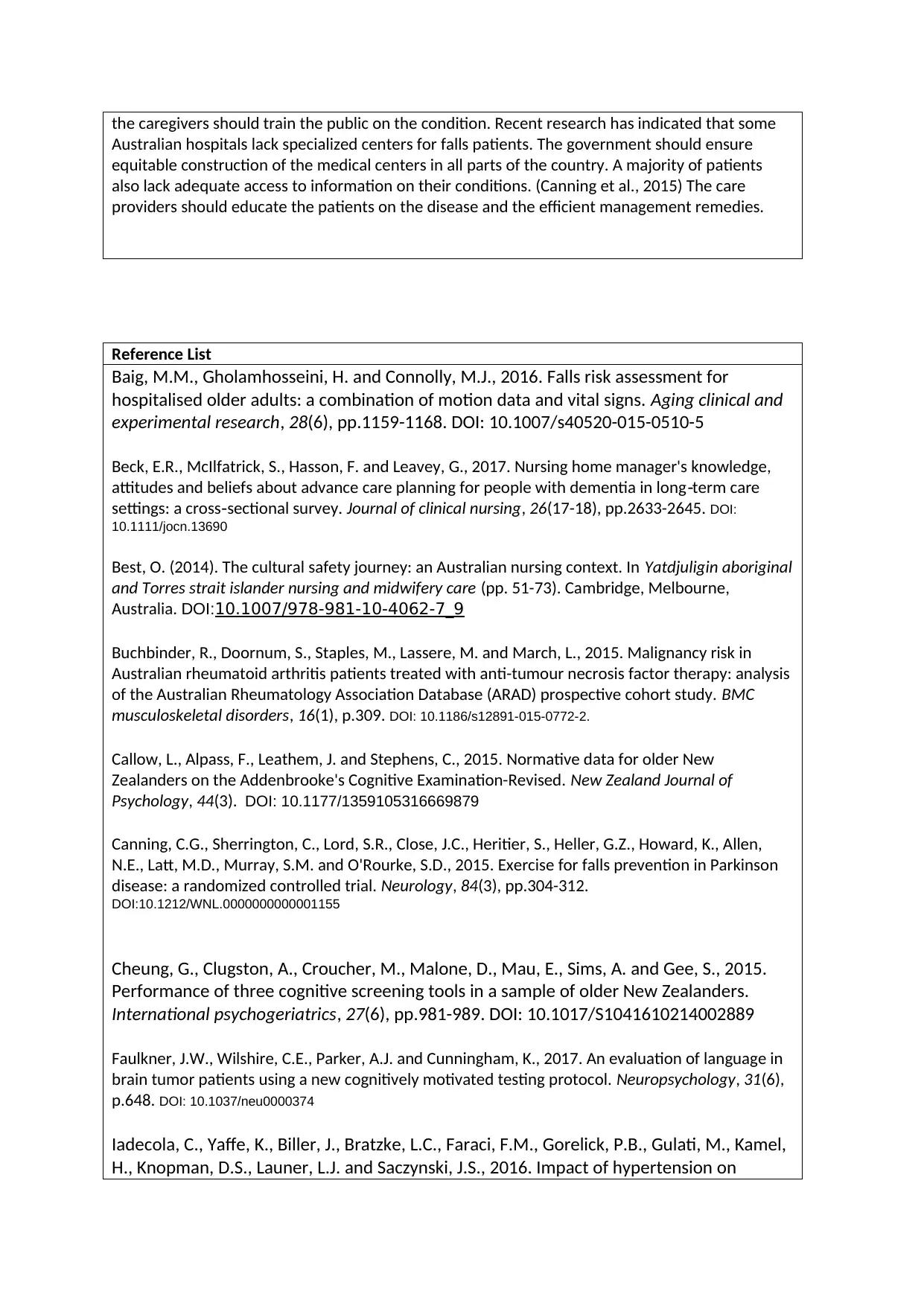
the caregivers should train the public on the condition. Recent research has indicated that some
Australian hospitals lack specialized centers for falls patients. The government should ensure
equitable construction of the medical centers in all parts of the country. A majority of patients
also lack adequate access to information on their conditions. (Canning et al., 2015) The care
providers should educate the patients on the disease and the efficient management remedies.
Reference List
Baig, M.M., Gholamhosseini, H. and Connolly, M.J., 2016. Falls risk assessment for
hospitalised older adults: a combination of motion data and vital signs. Aging clinical and
experimental research, 28(6), pp.1159-1168. DOI: 10.1007/s40520-015-0510-5
Beck, E.R., McIlfatrick, S., Hasson, F. and Leavey, G., 2017. Nursing home manager's knowledge,
attitudes and beliefs about advance care planning for people with dementia in long term care‐
settings: a cross sectional survey.‐ Journal of clinical nursing, 26(17-18), pp.2633-2645. DOI:
10.1111/jocn.13690
Best, O. (2014). The cultural safety journey: an Australian nursing context. In Yatdjuligin aboriginal
and Torres strait islander nursing and midwifery care (pp. 51-73). Cambridge, Melbourne,
Australia. DOI:10.1007/978-981-10-4062-7_9
Buchbinder, R., Doornum, S., Staples, M., Lassere, M. and March, L., 2015. Malignancy risk in
Australian rheumatoid arthritis patients treated with anti-tumour necrosis factor therapy: analysis
of the Australian Rheumatology Association Database (ARAD) prospective cohort study. BMC
musculoskeletal disorders, 16(1), p.309. DOI: 10.1186/s12891-015-0772-2.
Callow, L., Alpass, F., Leathem, J. and Stephens, C., 2015. Normative data for older New
Zealanders on the Addenbrooke's Cognitive Examination-Revised. New Zealand Journal of
Psychology, 44(3). DOI: 10.1177/1359105316669879
Canning, C.G., Sherrington, C., Lord, S.R., Close, J.C., Heritier, S., Heller, G.Z., Howard, K., Allen,
N.E., Latt, M.D., Murray, S.M. and O'Rourke, S.D., 2015. Exercise for falls prevention in Parkinson
disease: a randomized controlled trial. Neurology, 84(3), pp.304-312.
DOI:10.1212/WNL.0000000000001155
Cheung, G., Clugston, A., Croucher, M., Malone, D., Mau, E., Sims, A. and Gee, S., 2015.
Performance of three cognitive screening tools in a sample of older New Zealanders.
International psychogeriatrics, 27(6), pp.981-989. DOI: 10.1017/S1041610214002889
Faulkner, J.W., Wilshire, C.E., Parker, A.J. and Cunningham, K., 2017. An evaluation of language in
brain tumor patients using a new cognitively motivated testing protocol. Neuropsychology, 31(6),
p.648. DOI: 10.1037/neu0000374
Iadecola, C., Yaffe, K., Biller, J., Bratzke, L.C., Faraci, F.M., Gorelick, P.B., Gulati, M., Kamel,
H., Knopman, D.S., Launer, L.J. and Saczynski, J.S., 2016. Impact of hypertension on
Australian hospitals lack specialized centers for falls patients. The government should ensure
equitable construction of the medical centers in all parts of the country. A majority of patients
also lack adequate access to information on their conditions. (Canning et al., 2015) The care
providers should educate the patients on the disease and the efficient management remedies.
Reference List
Baig, M.M., Gholamhosseini, H. and Connolly, M.J., 2016. Falls risk assessment for
hospitalised older adults: a combination of motion data and vital signs. Aging clinical and
experimental research, 28(6), pp.1159-1168. DOI: 10.1007/s40520-015-0510-5
Beck, E.R., McIlfatrick, S., Hasson, F. and Leavey, G., 2017. Nursing home manager's knowledge,
attitudes and beliefs about advance care planning for people with dementia in long term care‐
settings: a cross sectional survey.‐ Journal of clinical nursing, 26(17-18), pp.2633-2645. DOI:
10.1111/jocn.13690
Best, O. (2014). The cultural safety journey: an Australian nursing context. In Yatdjuligin aboriginal
and Torres strait islander nursing and midwifery care (pp. 51-73). Cambridge, Melbourne,
Australia. DOI:10.1007/978-981-10-4062-7_9
Buchbinder, R., Doornum, S., Staples, M., Lassere, M. and March, L., 2015. Malignancy risk in
Australian rheumatoid arthritis patients treated with anti-tumour necrosis factor therapy: analysis
of the Australian Rheumatology Association Database (ARAD) prospective cohort study. BMC
musculoskeletal disorders, 16(1), p.309. DOI: 10.1186/s12891-015-0772-2.
Callow, L., Alpass, F., Leathem, J. and Stephens, C., 2015. Normative data for older New
Zealanders on the Addenbrooke's Cognitive Examination-Revised. New Zealand Journal of
Psychology, 44(3). DOI: 10.1177/1359105316669879
Canning, C.G., Sherrington, C., Lord, S.R., Close, J.C., Heritier, S., Heller, G.Z., Howard, K., Allen,
N.E., Latt, M.D., Murray, S.M. and O'Rourke, S.D., 2015. Exercise for falls prevention in Parkinson
disease: a randomized controlled trial. Neurology, 84(3), pp.304-312.
DOI:10.1212/WNL.0000000000001155
Cheung, G., Clugston, A., Croucher, M., Malone, D., Mau, E., Sims, A. and Gee, S., 2015.
Performance of three cognitive screening tools in a sample of older New Zealanders.
International psychogeriatrics, 27(6), pp.981-989. DOI: 10.1017/S1041610214002889
Faulkner, J.W., Wilshire, C.E., Parker, A.J. and Cunningham, K., 2017. An evaluation of language in
brain tumor patients using a new cognitively motivated testing protocol. Neuropsychology, 31(6),
p.648. DOI: 10.1037/neu0000374
Iadecola, C., Yaffe, K., Biller, J., Bratzke, L.C., Faraci, F.M., Gorelick, P.B., Gulati, M., Kamel,
H., Knopman, D.S., Launer, L.J. and Saczynski, J.S., 2016. Impact of hypertension on
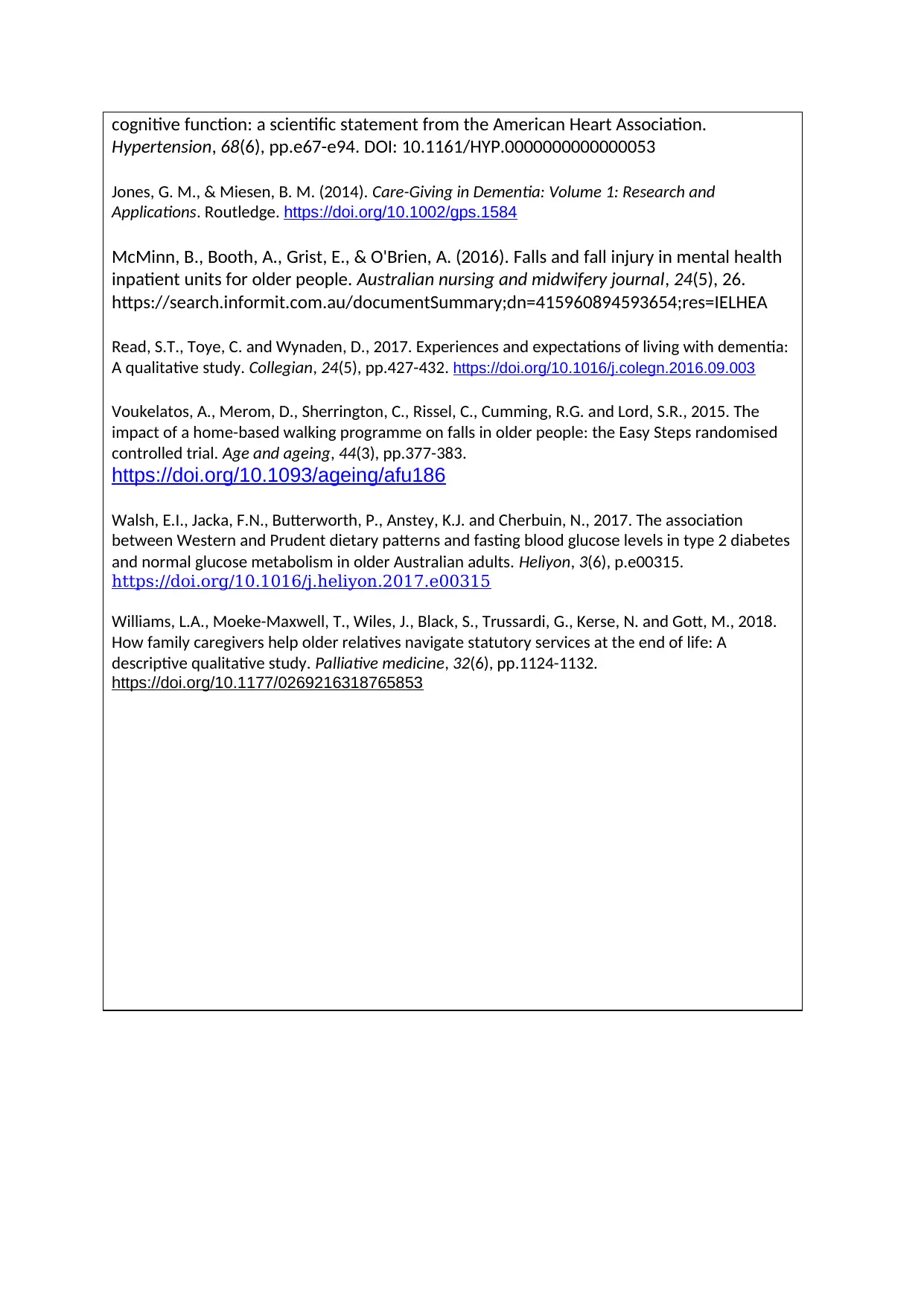
cognitive function: a scientific statement from the American Heart Association.
Hypertension, 68(6), pp.e67-e94. DOI: 10.1161/HYP.0000000000000053
Jones, G. M., & Miesen, B. M. (2014). Care-Giving in Dementia: Volume 1: Research and
Applications. Routledge. https://doi.org/10.1002/gps.1584
McMinn, B., Booth, A., Grist, E., & O'Brien, A. (2016). Falls and fall injury in mental health
inpatient units for older people. Australian nursing and midwifery journal, 24(5), 26.
https://search.informit.com.au/documentSummary;dn=415960894593654;res=IELHEA
Read, S.T., Toye, C. and Wynaden, D., 2017. Experiences and expectations of living with dementia:
A qualitative study. Collegian, 24(5), pp.427-432. https://doi.org/10.1016/j.colegn.2016.09.003
Voukelatos, A., Merom, D., Sherrington, C., Rissel, C., Cumming, R.G. and Lord, S.R., 2015. The
impact of a home-based walking programme on falls in older people: the Easy Steps randomised
controlled trial. Age and ageing, 44(3), pp.377-383.
https://doi.org/10.1093/ageing/afu186
Walsh, E.I., Jacka, F.N., Butterworth, P., Anstey, K.J. and Cherbuin, N., 2017. The association
between Western and Prudent dietary patterns and fasting blood glucose levels in type 2 diabetes
and normal glucose metabolism in older Australian adults. Heliyon, 3(6), p.e00315.
https://doi.org/10.1016/j.heliyon.2017.e00315
Williams, L.A., Moeke-Maxwell, T., Wiles, J., Black, S., Trussardi, G., Kerse, N. and Gott, M., 2018.
How family caregivers help older relatives navigate statutory services at the end of life: A
descriptive qualitative study. Palliative medicine, 32(6), pp.1124-1132.
https://doi.org/10.1177/0269216318765853
Hypertension, 68(6), pp.e67-e94. DOI: 10.1161/HYP.0000000000000053
Jones, G. M., & Miesen, B. M. (2014). Care-Giving in Dementia: Volume 1: Research and
Applications. Routledge. https://doi.org/10.1002/gps.1584
McMinn, B., Booth, A., Grist, E., & O'Brien, A. (2016). Falls and fall injury in mental health
inpatient units for older people. Australian nursing and midwifery journal, 24(5), 26.
https://search.informit.com.au/documentSummary;dn=415960894593654;res=IELHEA
Read, S.T., Toye, C. and Wynaden, D., 2017. Experiences and expectations of living with dementia:
A qualitative study. Collegian, 24(5), pp.427-432. https://doi.org/10.1016/j.colegn.2016.09.003
Voukelatos, A., Merom, D., Sherrington, C., Rissel, C., Cumming, R.G. and Lord, S.R., 2015. The
impact of a home-based walking programme on falls in older people: the Easy Steps randomised
controlled trial. Age and ageing, 44(3), pp.377-383.
https://doi.org/10.1093/ageing/afu186
Walsh, E.I., Jacka, F.N., Butterworth, P., Anstey, K.J. and Cherbuin, N., 2017. The association
between Western and Prudent dietary patterns and fasting blood glucose levels in type 2 diabetes
and normal glucose metabolism in older Australian adults. Heliyon, 3(6), p.e00315.
https://doi.org/10.1016/j.heliyon.2017.e00315
Williams, L.A., Moeke-Maxwell, T., Wiles, J., Black, S., Trussardi, G., Kerse, N. and Gott, M., 2018.
How family caregivers help older relatives navigate statutory services at the end of life: A
descriptive qualitative study. Palliative medicine, 32(6), pp.1124-1132.
https://doi.org/10.1177/0269216318765853

1 out of 7
Related Documents
Your All-in-One AI-Powered Toolkit for Academic Success.
+13062052269
info@desklib.com
Available 24*7 on WhatsApp / Email
![[object Object]](/_next/static/media/star-bottom.7253800d.svg)
Unlock your academic potential
© 2024 | Zucol Services PVT LTD | All rights reserved.





